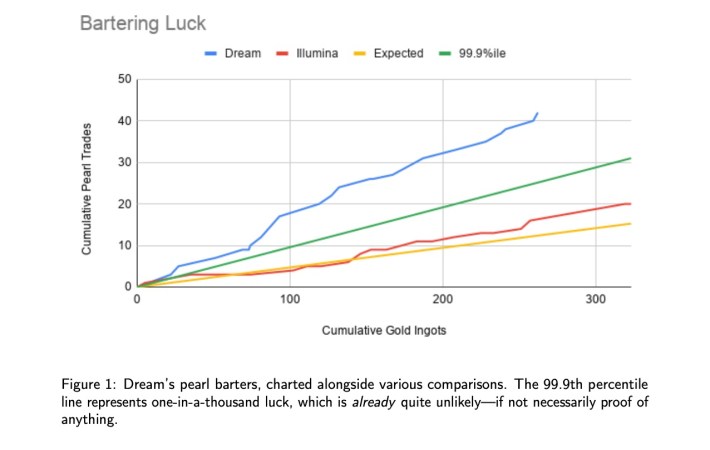There is a somewhat inscrutable scandal currently rippling through the gamer universe on YouTube, although that is true on any given day, since big-time YouTube platforms, creators, and communities thrive on and grow from internecine feuds and similar conflicts. It's pro wrestling, but with the wrestling replaced by uploads like "Hunting ghosts while wearing a heart rate monitor! (Phasmophobia)." Tuesday's spectacle concerns Dream, one of the best Minecraft players in the world, and whether he cheated while notching one of his elite times in a speedrun of the game.
Dream has vaulted into the upper echelons of gaming YouTube fame this year, according to Patricia Hernandez at Polygon, gaining over 10 million of his 14 million subscribers in 2020. YouTube named him the top trending and second overall creator on the platform this year. Those accolades aren't determinative, but they do indicate how thoroughly he's blown up. The surge can be chalked up to Dream distinguishing himself as a top-tier Minecraft speedrunner, learning and revealing the seed code for a Minecraft world created by PewDiePie, and starting to post regular videos after the success of "this cursed Minecraft video will trigger you... ."
Dream currently owns the sixth-fastest verified time on Minecraft version 1.14.4, and until recently he also owned a record on the 1.16 version, but speedrun.com stripped the record after a two-month investigation. The 29-page, 10,000-word breakdown of the decision, released last Friday, showed that Dream's record-setting time was either the product of 1-in-7.5 trillion luck or, more likely, an illegal manipulation of the game's engine.
The paper goes into extreme detail. While the thorough examination of statistics equations and Minecraft's randomness engines provides a fairly complete picture of every facet of the scandal surrounding the 19:24 speedrun, the discrepancy under scrutiny is actually reasonably simple to understand: Two critical resources only attainable via random drops appeared for Dream at almost impossibly aberrant rates.
"The main focus during the beginning of a 1.16 RSG speedrun," the paper states, "is to obtain (hopefully) 12 Eyes of Ender as quickly as possible, by bartering with piglins and killing blazes." To unlock the final boss, a player needs 10 to 12 Eyes of Ender, which are crafted with one Ender Pearl and one Blaze Powder. Ender Pearls are obtained by bartering gold ingots for a random item with a Piglin Merchant in the netherworld. There is a five percent chance that the merchant trades the player an Ender Pearl, and while there are other ways of obtaining the resource, this is the most reliable option. Blaze Powder is crafted from Blaze Rods, which drop 50 percent of the time a player slays an enemy called—you guessed it—Blaze.
According to data reviewed from six of Dream's speedrun attempts, "42 of the 262 piglin barters performed throughout these streams yielded Ender Pearls, and 211 of the 305 killed blazes dropped Blaze Rods." The team plugged those numbers into a series of statistical equations. Even given the most charitable possible precepts (e.g.: Dream definitionally would have to be disproportionately lucky in order to achieve a record time, and he also stopped streaming after the successful run, removing the possibility of future unlucky runs, etc.), they found that the chances of him having such good barter luck was 1-in-82 billion. The chances of him acquiring a Blaze Rod that often was 1-in-113 billion.

Either one of those figures on its own would be damning, but the odds of them both being produced simultaneously is 1-in-7.5 trillion. A Reddit user ran 1.7 billion simulations and never reached either of Dream's highs, let alone both in the same run. Minecraft's files are not terribly difficult to manipulate, and it doesn't take a sophisticated modification, any serious programming knowledge, or alteration of datapacks to cheat in a simple yet crucial way. If any of this is confusing, Geosquare, a moderator on the Minecraft speedrunning team that produced the paper, summed the whole affair up in a rather digestible video.
For his part, Dream has consistently denied that he cheated. He pointed out a few minor discrepancies with Geosquare's video, including a claim that Dream had failed to provide moderators with adequate forensic data. He turned over files showing what programs were running when he completed the speedrun and also released it to the public.
My 1.16 run was just rejected after research due to it being "too unlikely to verify". A video was made by a head mod and Youtuber Geosquare, using my name and clickbaiting "Cheating Speedrunning" in order to get easy views. Definitely a response soon. Total BS!
— dream (@dreamwastaken) December 11, 2020
However, the moderation team noted that Dream could have changed the files in the 10-day period between the run and the outset of the investigation. Geosquare also addressed Dream's defense that Java is somehow glitched and that the random number generators that Minecraft uses are unreliable. As he explained, Pearl drop luck and Blaze Rod drop luck are determined by different generators.
Dream has apologized for being rude to the moderation team, while also promising a thorough video clarifying how he was able to achieve the record time. That's a less petulant response to scrutiny than yelling at your accusers that they've been doing "PIPI in your pampers."






